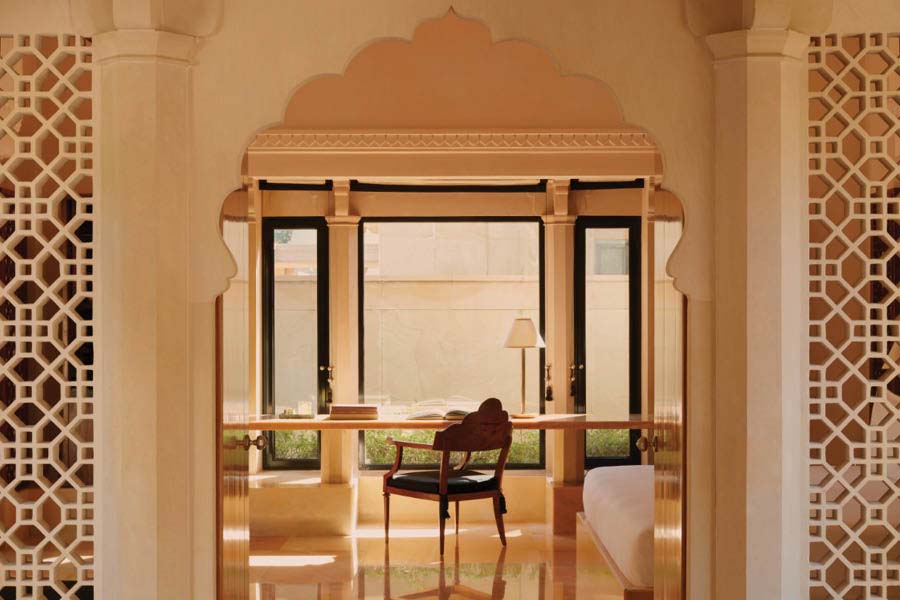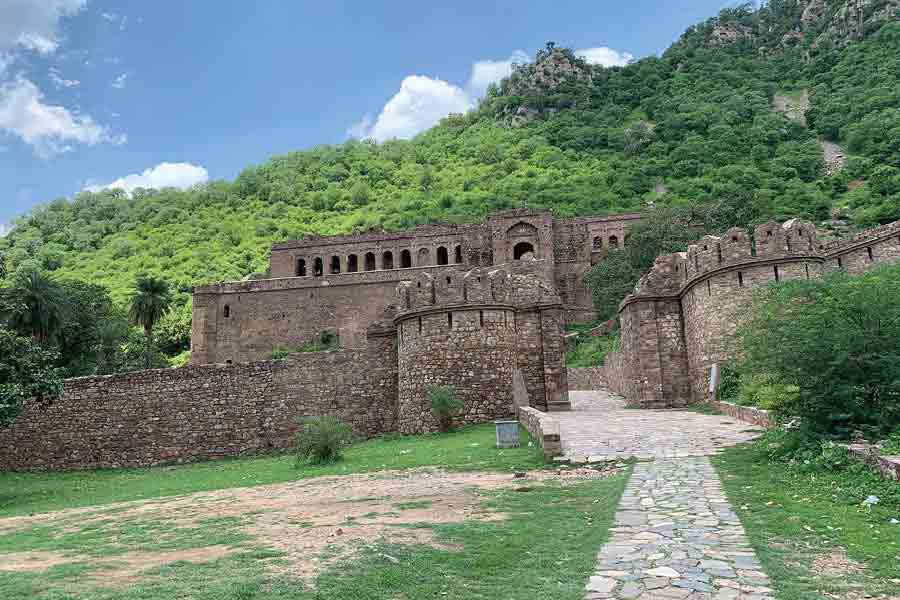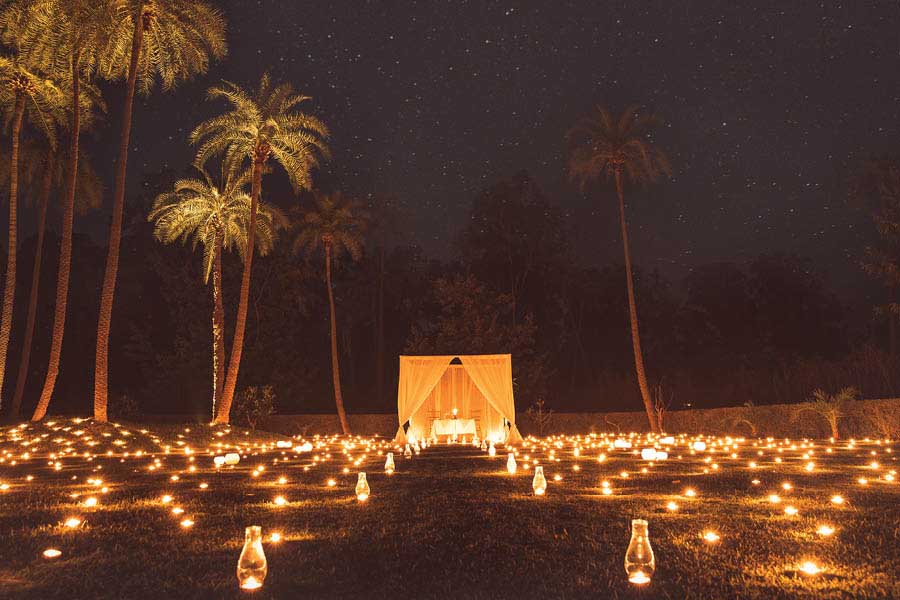Hidden away from the world, the wonder that is Amanbagh lies in Ajabgarh, Rajasthan. A two-hour car ride away from Jaipur, Ajabgarh was formerly the hunting ground for Jai Singh Prabhakar, the maharaja of Alwar. It was not until 2002 when Adrian Zechha, an Indonesian hotelier, was passing by Ajabgarh that he noticed beautiful palm trees in the area and decided to create Amanbagh.
In the course of time, Amanbagh, a property of the Aman group, has become a destination in itself, built upon Marwari traditions, architecture, food, cultural values and, most of all, a distinctive sense of hospitality that welcomes guests from across the world. Ed Tuttle, the master architect of the property, had 47 acres of land to play with in terms of the design — all in the middle of the enchanting Aravalli hills, surrounded by tigers and leopards within the Sariska National Park. Tuttle converted this piece of land in Ajabgarh into Amanbagh by using the three main building materials available across Rajasthan — red sandstone from Dholpur, green marble from Udaipur and pink marble from Makrana.
Hospitality and architecture

The arches and the pillars at Amanbagh are in keeping with the traditional architecture of the area
AmanbaghFor those who do not want to spend two hours commuting from Jaipur in a car, Amanbagh houses a helipad. A lady clad in a saffron sari sings the Gayatri mantra to mark your entry into Amanbagh. There are no signboards proclaiming the property’s presence, a subtle touch often appreciated by globetrotters.
The several arches across Amanbagh give it a feel of an old Rajput palace, while its pillars recall the temples in Jaipur, Varanasi and Hampi. Even the chairs have a regal touch to them, with the silver lion heads engraved on them serving as a reminder of the royal pastime. Lattice work comprising symmetrical patterns on the red sandstone distinguishes the various balconies of the property. This lattice work is key to the 18th century Marwari tradition (also observed in the Hawa Mahal in Jaipur) of allowing women to look at public events while not being seen from outside. The lattice design now blends into modern elements at Amanbagh.
The pool pavilion, behind the villa, features a luxurious plunge pool and a sprawling garden. According to Rajput tradition, any bathing space should be behind the palace to ensure the privacy of the royals. Amanbagh also boasts a grand bathtub carved out of a single, green Udaipur marble. While bathing in it, with light seeping in from the circular translucent glass, the views of the grand dome feel majestic. The bathing area has separate dressers for men and women. The male dresser has a dedicated section for shaving, while the women’s section houses a make-up dresser. If the bathing experience is not enough, the spa at Amanbagh offers a maharani /maharaja spa using local oils.
The culture of giving back

An excursion to the Bhangarh fort is among the experiences Amanbagh curates for guests
Wikimedia CommonsThe Amanbagh library has an enviable collection, including Arts and Crafts of Rajasthan by Aman Nath and Francis Wacziarg, The Heritage of Indian Tea by DK Taknet, Marwar: The Legend of the Indian Horse by Fransesca Kelly and Dale Durfee, and Rajasthan: A Land of Splendor and Bravery by Suzanne Held. While enjoying a rare book at this library, you are likely to hear a peacock calling out to its mate. From carpets showcasing vibrant peacocks to wall-hangings featuring dancing peacocks, Amanbagh is an ode to peacocks and their importance in Hindu culture.
Beyond its commitment to the past, Amanbagh signifies a much-needed accountability for the future, also in line with Marwari culture. Maharajas in Rajasthan are known for giving back to the community and taking care of the environment. Amanbagh stands by these principles and contributes towards creating a positive impact on the local community in Ajabgarh, be it collaborating with local schools to host yoga and English classes or hosting free health check-ups for residents by in-house doctors. The goal is conscious tourism, wherein tourists leave with an understanding of the local culture.
The “Cow Dust Tour” during sunset as well as a local excursion organised by Amanbagh exposes tourists to Ajabgarh in an open jeep. Slowly, the humble surroundings, lush vegetation, sprawling mountains and vast skies make themselves clear. Some tourists who visit Ajabgarh end up staying back to teach at local schools, host donation drives or learn even more about the local culture. Additionally, there is also an excursion to the Bhangarh fort, frequently found on lists of most haunted places.
A bevy of birds and dining under the stars

Special candlelight dinners arranged by Amanbagh feature as many as 200 diyas
AmanbaghAmanbagh has 450 trees on its premises, including varieties of guava, jamun, gooseberries, lemon and date palm trees. Birds are welcome at the property, even during breakfast on the outdoor tables. I spotted parrots, golden-backed woodpeckers, owls, quails, drongos, sunbirds, serpent eagles and sandgrouses, among other birds, during my stay.
Amanbagh pays homage to centuries of Rajasthani food tradition with a dedicated Rajasthani breakfast comprising Thana Gazi Matar ka Paratha, kota kachori, puri bhaji, rathori bajra, Rajasthani korma paratha, Eklingji Mirchi Vada and Shekhawati Bajra Methi Puri, among other dishes. At dinner, guests can listen to local folk music sung by artistes from the Langa community near Jaisalmer, who specialise in singing and dancing to Marwari songs. There is also the option of a special candlelight dinner, with over 200 diyas spread across the garden, a private flute player and the glory of the midnight sky in Rajasthan.
As I was leaving Amangbagh, I felt a strange sensation of being called back. But life cannot stop too long for luxury. With a picture clicked near the Shiva temple at the property, I put some jaggery and curd in my mouth (a Marwari tradition to mark a safe journey) and bid goodbye to Amanbagh with the hope of a swift return.








